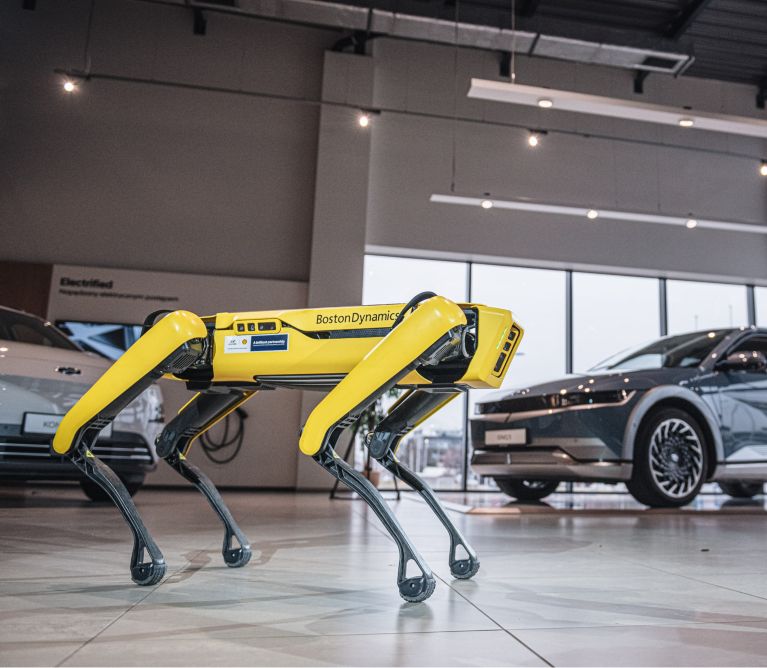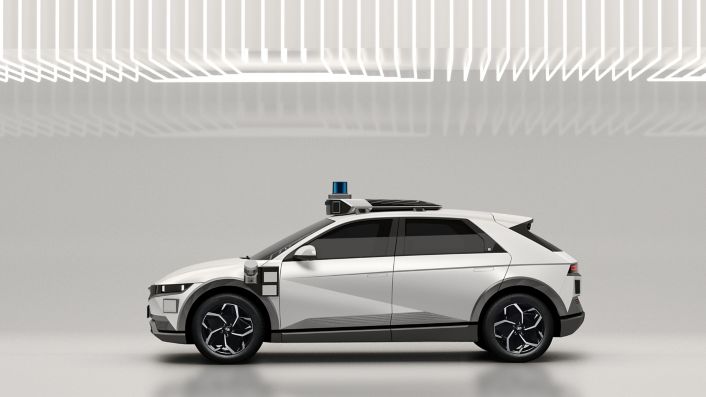- Hyundai Motor Poland presented Boston Dynamics’ quadruped robot Spot® to customers and media
- On 7 February, Spot® was presented during dedicated live broadcast of Onet Rano, the most popular Polish online morning show
- Spot® visited four Hyundai Electrified Showroom in Poland, in Gdańsk, Poznań, Wrocław, and Warszawa
- On 8 February, Spot® was presented to most prominent Polish technology, business, and automotive journalists along with Hyundai’s vision of “Progress for Humanity”. During the presentation, Spot® danced to BTS’ popular song “I’m On It”
Press material
-
Download
-
Images
Hyundai Motor Poland presented the Boston Dynamics’ quadruped robot Spot® to customers and media. From 20 January to 8 February, Spot® visited four Hyundai Electrified Showrooms in Poland – in Gdańsk, Poznań, Wrocław, and Warszawa.
On 7 February, Spot® was also presented to a broader Polish audience during a live broadcast of Onet Rano, Poland’s most popular online morning show. During a 20-minute interview, journalist Janusz Schwertner spoke with Michał Dziwulski (Product, Hyundai Motor Poland) and Agnieszka Piłat (artist, painter, Boston Dynamics robot trainer in San Diego, California) about Hyundai’s vision of Progress for Humanity, electromobility, robotics, and how robots would affect people’s safety and comfort in the future. The interview was broadcasted from the Hyundai Dealer Electrified Showroom in Warsaw. The agile robot was present during the entire interview, walking around the space. In one day, this broadcast generated more than 0.5 million views.
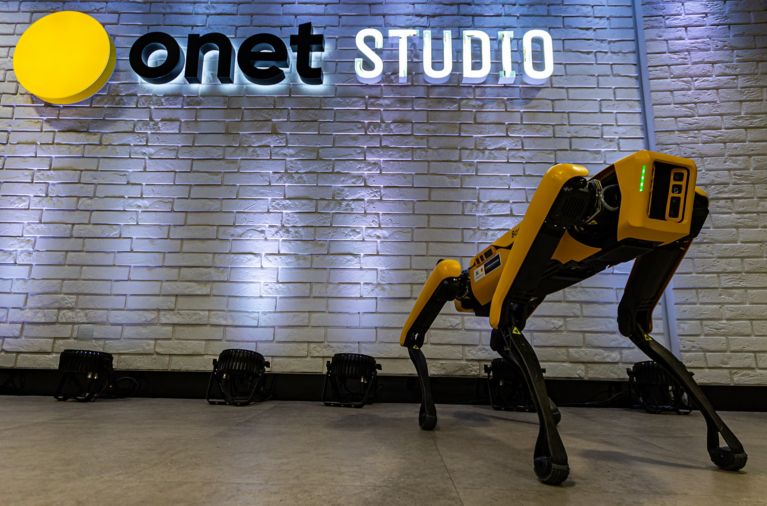
The interview was part of Hyundai Motor Poland x Onet Rano yearlong cooperation, aimed to promote electromobility. For one year, journalists of Onet Rano will be using the fully-electric IONIQ 5 as a mobile studio, inviting guests to discuss political and social issues.
On 8 February, Spot® was presented to the most prominent Polish technology, business, and automotive journalists, again along with Hyundai’s vision of Progress for Humanity and Hyundai’s transformation into a Smart Mobility Solutions Provider. Hyundai develops solutions beyond cars: commercial hydrogen vehicles, Urban Air Mobility, robotics, and autonomous driving. After the presentation, Spot® danced to BTS' popular song “I’m On It”.
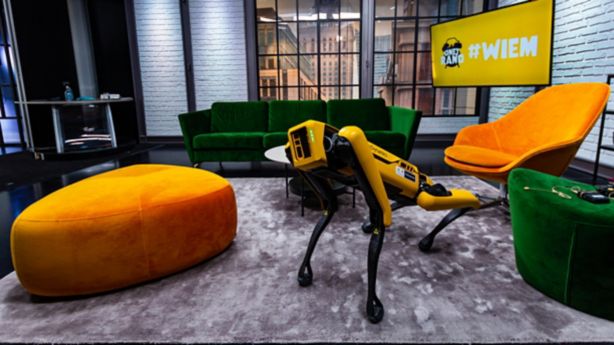

Throughout the year, Spot® will embark on a European tour. The first leg of the tour has already been concluded in Poland with events at four Hyundai Electrified Showrooms – Margo, Nawrot, Karlik, and Auto G.T. Warsaw.
Spot® is now headed to the Czech Republic, where it will be present at the grand opening of an EV showroom in Prague. From April to July, Spot® will be in the UK, and the tour will continue in Trondheim, Norway. The final leg of the European tour is still in planning.
Progress for Humanity
Hyundai Motor Company is striving to provide freedom of movement to everyone by investing in mobility services, building a close relationship with leading mobility service providers and expanding our role beyond the automotive transportation sector. The company will play a pivotal role in global society’s transition to clean energy by helping make hydrogen an economically viable energy source.
IONIQ Line-Up Brand
By 2025, Hyundai expects to sell 560,000 battery electric vehicles worldwide and have introduced more than 13 BEVs built on E-GMP, Hyundai Motor Group’s first dedicated EV platform. Under the IONIQ line-up brand, Hyundai will offer customer-centric EV experiences centred on connected lifestyle solutions. The first model under IONIQ was the fully-electric midsize CUV IONIQ 5 launched in early 2021. IONIQ 5 is based on the concept EV ‘45’, which Hyundai unveiled at the International Motor Show (IAA) 2019 in Frankfurt as a homage to its very first concept car. IONIQ 5’s designers took inspiration from the past and integrated it with cutting-edge parametric pixels, a unique design element that Hyundai designers will continue to incorporate into future IONIQ models: IONIQ 6 sedan (2022) and IONIQ 7 SUV (2024).
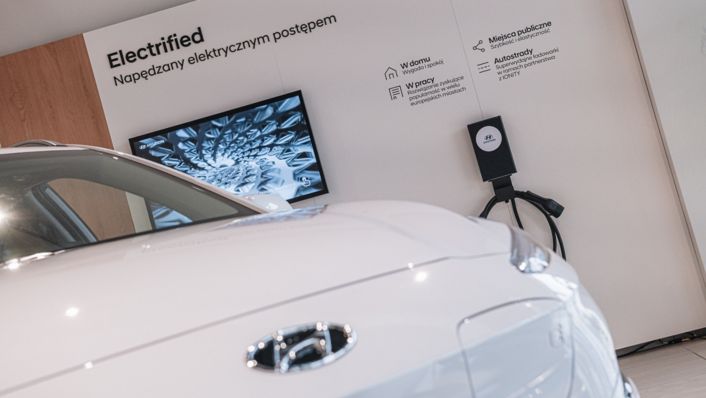
Hyundai Electrified Showrooms
Hyundai Electrified Showroom is a new concept of Hyundai showrooms, in which customers have better access to electrified models. Among all car manufacturers, Hyundai offers the widest range of electrified powertrains, including mild hybrids, hybrids, plug-in hybrids, BEVs and FCEVs. In Poland, there are already four Hyundai Electrified Showrooms in the cities of Gdańsk, Poznań, Warsaw, and Wrocław.
Hyundai electrified models:
- MHEV (Mild Hybrid): i30, TUCSON
- HEV (Hybrid): KONA Hybrid, TUCSON Hybrid, SANTA FE Hybrid
- PHEV (Plug-in Hybrid): TUCSON Plug-in, SANTA FE Plug-in
- EV (Electric): KONA Electric, IONIQ 5
- FCEV (Hydrogen): NEXO
Mobile services:
- Hyundai BlueLink (app)
- Remote control of the car’s functions (key, air conditioning)
- Car monitoring, navigation while parking
- Sharing with other users
- Charge myHyundai (app/service)
- More than 300,000 charging stations across Europe
- One card, one fee + attractive subscription packages
- Access to ultra-fast IONITY chargers up to 350 kW
IONIQ 5 Robotaxis
Motional, a joint venture between Hyundai and Aptiv, has announced that their latest driverless IONIQ 5-based robotaxi (IONIQ 5 Robotaxi) will be available from 2023. Based on the fully-electric IONIQ 5, IONIQ 5 Robotaxi is an SAE Level 4 autonomous vehicle that can operate without a driver. The first key benefit of autonomous robotaxis is the safety aspect. Driverless technology will significantly improve the safety of our roads by eliminating accidents caused by human error, which will save millions of lives. The next benefit is that Hyundai believes autonomous vehicles will provide a more accessible, affordable, and reliable form of transportation for everyone. That is why Hyundai is building IONIQ 5 Robotaxis to offer improved mobility options to a wide range of users across the world.
Robotics
With wearable exoskeletons, unmanned vehicles, and all-terrain rovers, Hyundai is developing the future of mobility beyond passenger cars. Based on the vision for Progress for Humanity, the company is devoted to the research and development of robots.
Hyundai robots:
- Wearable exoskeletons
- MEX: Medical EXoskeleton
- CEX: Chairless EXoskeleton
- VEX: Vest EXoskeleton
- Service robots
- DAL-e: Drive you, Assist you, Link with you – experience
- H2D2: Hyundai Hotel Delivery Droid
- ACR: Automatic Charging Robot
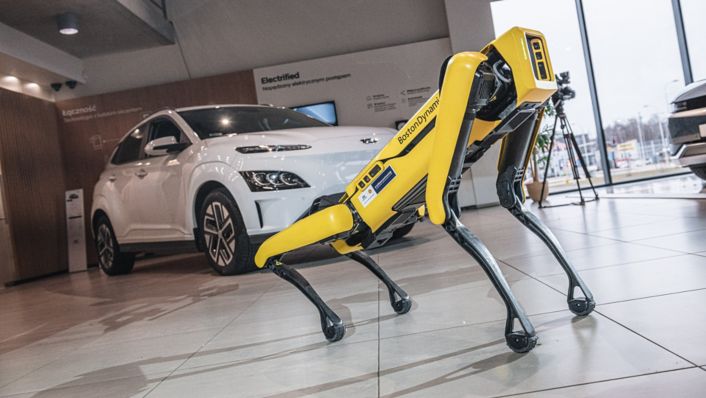
Boston Dynamics
In 2021, Hyundai Motor Group acquired a controlling interest in Boston Dynamics.
Boston Dynamics is the established leader in developing agile, mobile robots that have been successfully integrated into the business operations of many of the world’s leading industrial firms. Advanced robotics offer opportunities for rapid growth with the potential to positively impact society by making work safer and more productive.
By acquiring Boston Dynamics and securing a leading presence in the field of robotics, the Group took another major step toward its strategic transformation into a Smart Mobility Solution Provider. In the field of robotics, the Group aims to develop advanced technologies that enhance people’s lives and promote safety, thereby realising Progress for Humanity.
Boston Dynamics launched sales of its first commercial robot, the quadruped Spot® in June of 2020 and now has hundreds of robots operating in a variety of industries, including power utilities, construction, manufacturing, oil and gas, and mining.
Disclaimer: CO2 and emissions data
- Fuel consumption combined for the Hyundai i30 1.5 DPI in l/100 km: 6.8 - 6.0; CO2 emissions combined in g/km: 153.2 - 136.5 (WLTP)
- Fuel consumption combined for the Hyundai i30 1.0 T-GDI with 6MT in l/100 km: 6.2 - 5.4; CO2 emissions combined in g/km: 140.6 - 123.2 (WLTP)
- Fuel consumption combined for the Hyundai i30 1.0 T-GDI with 7DCT in l/100 km: 6.4 - 5.7; CO2 emissions combined in g/km: 144.1 - 128.3 (WLTP)
- Fuel consumption combined for the Hyundai i30 1.0 T-GDI 48V with 6iMT in l/100 km: 6.0 - 5.3; CO2 emissions combined in g/km: 137 - 119.9 (WLTP)
- Fuel consumption combined for the Hyundai i30 1.0 T-GDI 48V with 7DCT in l/100 km: 6.2 - 5.4; CO2 emissions combined in g/km: 140.3 - 121 (WLTP)
- Fuel consumption combined for the Hyundai i30 1.5 T-GDI 48V with 6iMT in l/100 km: 6.5 - 5.6; CO2 emissions combined in g/km: 148.2 - 126.4 (WLTP)
- Fuel consumption combined for the Hyundai i30 1.5 T-GDI 48V with 7DCT in l/100 km: 6.3 - 5.5; CO2 emissions combined in g/km: 142.1 - 125.7 (WLTP)
- Fuel consumption combined for the Hyundai i30 1.6 CRDi with 6MT in l/100 km: 5.1 - 4.5; CO2 emissions combined in g/km: 134.6 - 118.4 (WLTP)
- Fuel consumption combined for the Hyundai i30 1.6 CRDi with 7DCT in l/100 km: 4.9 - 4.6; CO2 emissions combined in g/km: 126.9 - 121 (WLTP)
- Fuel consumption combined for the Hyundai i30 1.6 CRDi 48V with 6MT in l/100 km: 5.3 - 4.6; CO2 emissions combined in g/km: 137.5 - 120.3 (WLTP)
- Fuel consumption combined for the Hyundai i30 1.6 CRDi 48V with 7DCT in l/100 km: 5.1 - 4.8; CO2 emissions combined in g/km: 134.1 - 125.1 (WLTP)
- Fuel consumption combined for the Hyundai KONA 1.0 T-GDI with 6MT 2WD in l/100 km: 6.1 - 5.7; CO2 emissions combined in g/km: 137 - 128 (WLTP)
- Fuel consumption combined for the Hyundai KONA 1.0 T-GDI with 7DCT 4WD in l/100 km: 6.0 - 5.8; CO2 emissions combined in g/km: 137 - 132 (WLTP)
- Fuel consumption combined for the Hyundai KONA 1.0 T-GDI 48V with 6iMT 2WD in l/100 km: 6.1 - 5.5; CO2 emissions combined in g/km: 139 - 124 (WLTP)
- Fuel consumption combined for the Hyundai KONA 1.6 T-GDI with 7DCT 2WD in l/100 km: 6.7 - 6.2; CO2 emissions combined in g/km: 152 - 142 (WLTP)
- Fuel consumption combined for the Hyundai KONA 1.6 T-GDI with 7DCT 4WD in l/100 km: 7.4 - 7.0; CO2 emissions combined in g/km: 167 - 160 (WLTP)
- Fuel consumption combined for the Hyundai KONA 1.6 CRDi with 6iMT 2WD in l/100 km: 5.2 - 4.7; CO2 emissions combined in g/km: 136 - 124 (WLTP)
- Fuel consumption combined for the Hyundai KONA 1.6 CRDi with 7DCT 2WD in l/100 km: 5.2 - 4.7; CO2 emissions combined in g/km: 136 - 124 (WLTP)
- Fuel consumption combined for the Hyundai KONA 1.6 CRDi with 7DCT 4WD in l/100 km: 5.6 - 5.2; CO2 emissions combined in g/km: 147 - 137 (WLTP)
- Fuel consumption combined for the Hyundai KONA Hybrid 1.6 GDI Hybrid in l/100 km: 5.4 - 5.0; CO2 emissions combined in g/km: 122 - 114 (WLTP)
- Electricity consumption combined for the Hyundai KONA Electric 39.2 kWh in kWh/100 km: 14.3; CO2 emissions combined in g/km: 0 (WLTP)
- Electricity consumption combined for the Hyundai KONA Electric 64 kWh in kWh/100 km: 14.7; CO2 emissions combined in g/km: 0 (WLTP)
- Fuel consumption combined for the Hyundai TUCSON 1.6 T-GDI 48V (150 PS) with 6iMT 2WD in l/100 km: 6.8 - 6.5; CO2 emissions combined in g/km: 154 - 147 (WLTP)
- Fuel consumption combined for the Hyundai TUCSON 1.6 T-GDI 48V (150 PS) with 7DCT 2WD in l/100 km: 6.6 - 6.3; CO2 emissions combined in g/km: 150 - 143 (WLTP)
- Fuel consumption combined for the Hyundai TUCSON 1.6 T-GDI 48V (180 PS) with 6iMT 2WD in l/100 km: 6.7 - 6.4; CO2 emissions combined in g/km: 152 - 145 (WLTP)
- Fuel consumption combined for the Hyundai TUCSON 1.6 T-GDI 48V (180 PS) with 7DCT 4WD in l/100 km: 7.1 - 6.9; CO2 emissions combined in g/km: 162 - 156 (WLTP)
- Fuel consumption combined for the Hyundai TUCSON 1.6 CRDi 48V (136 PS) with 6iMT 2WD in l/100 km: 5.3 - 5.0; CO2 emissions combined in g/km: 140 - 130 (WLTP)
- Fuel consumption combined for the Hyundai TUCSON 1.6 CRDi 48V (136 PS) with 7DCT 2WD in l/100 km: 5.6 - 5.2; CO2 emissions combined in g/km: 146 - 137 (WLTP)
- Fuel consumption combined for the Hyundai TUCSON 1.6 CRDi 48V (136 PS) with 7DCT 4WD in l/100 km: 6.0 - 5.7; CO2 emissions combined in g/km: 158 - 149 (WLTP)
- Fuel consumption combined for the Hyundai TUCSON 1.6 T-GDI (150 PS) with 6MT 2WD in l/100 km: 7.0 - 6.6; CO2 emissions combined in g/km: 159 - 150 (WLTP)
- Fuel consumption combined for the Hyundai TUCSON 1.6 T-GDI (150 PS) with 6MT 4WD in l/100 km: 7.8 - 7.3; CO2 emissions combined in g/km: 178 - 165 (WLTP)
- Fuel consumption combined for the Hyundai TUCSON 1.6 CRDi (115 PS) with 6MT 2WD in l/100 km: 5.6 - 5.2; CO2 emissions combined in g/km: 146 - 137 (WLTP)
- Fuel consumption combined for the Hyundai TUCSON 1.6 T-GDI Hybrid with 6AT 2WD in l/100 km: 5.9 - 5.5; CO2 emissions combined in g/km: 135 - 125 (WLTP)
- Fuel consumption combined for the Hyundai TUCSON 1.6 T-GDI Hybrid with 6AT 4WD in l/100 km: 6.6 - 6.2; CO2 emissions combined in g/km: 149 - 140 (WLTP)
- Fuel consumption combined for the Hyundai TUCSON 1.6 T-GDI Plug-in Hybrid with 6AT 4WD in l/100 km: 1.4; CO2 emissions combined in g/km: 31 (WLTP)
- Fuel consumption combined for the Hyundai SANTA FE 1.6 T-GDI Hybrid with 6AT 2WD in l/100 km: 6.9 - 6.4; CO2 emissions combined in g/km: 157 - 146 (WLTP)
- Fuel consumption combined for the Hyundai SANTA FE 1.6 T-GDI Hybrid with 6AT 4WD in l/100 km: 7.6 - 6.9; CO2 emissions combined in g/km: 172 - 157 (WLTP)
- Fuel consumption combined for the Hyundai SANTA FE 1.6 T-GDI Plug-in Hybrid in l/100 km: 1.6; electricity consumption combined in kWh/100 km: 18.1; CO2 emissions combined in g/km: 37 (WLTP)
- Fuel consumption combined for the Hyundai SANTA FE 2.2 CRDi with 8DCT 2WD in l/100 km: 6.3 - 6.1; CO2 emissions combined in g/km: 166 - 161 (WLTP)
- Fuel consumption combined for the Hyundai SANTA FE 2.2 CRDi with 8DCT 4WD in l/100 km: 6.9 - 6.7; CO2 emissions combined in g/km: 181 - 176 (WLTP)
- Electricity consumption combined for the Hyundai IONIQ 5 58 kWh with 2WD in kWh/100 km: 16.7; CO2 emissions combined in g/km: 0 (WLTP)
- Electricity consumption combined for the Hyundai IONIQ 5 58 kWh with 4WD in kWh/100 km: 18.1; CO2 emissions combined in g/km: 0 (WLTP)
- Electricity consumption combined for the Hyundai IONIQ 5 72.6 kWh (19” alloy rims) with 2WD in kWh/100 km: 16.8; CO2 emissions combined in g/km: 0 (WLTP)
- Electricity consumption combined for the Hyundai IONIQ 5 72.6 kWh (20” alloy rims) with 2WD in kWh/100 km: 17.9; CO2 emissions combined in g/km: 0 (WLTP)
- Electricity consumption combined for the Hyundai IONIQ 5 72.6 kWh (19” alloy rims) with 4WD in kWh/100 km: 17.7; CO2 emissions combined in g/km: 0 (WLTP)
- Electricity consumption combined for the Hyundai IONIQ 5 72.6 kWh (20” alloy rims) with 4WD in kWh/100 km: 19.0; CO2 emissions combined in g/km: 0 (WLTP)
- Hydrogen consumption combined for the Hyundai NEXO in kg H2/100 km: 0.95; CO2 emissions combined in g/km: 0 (WLTP)

